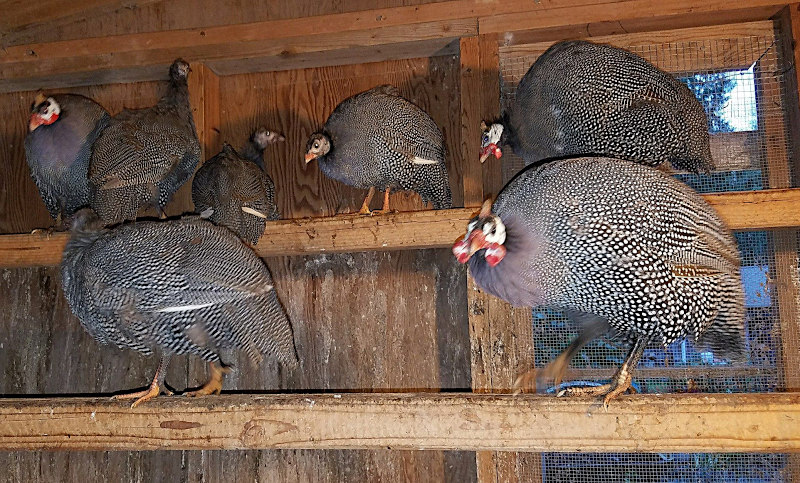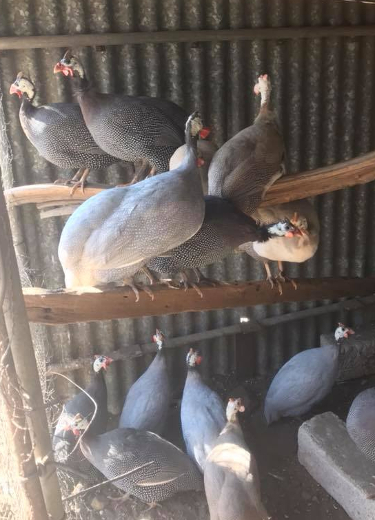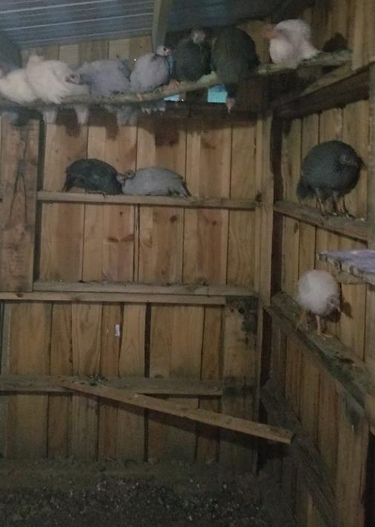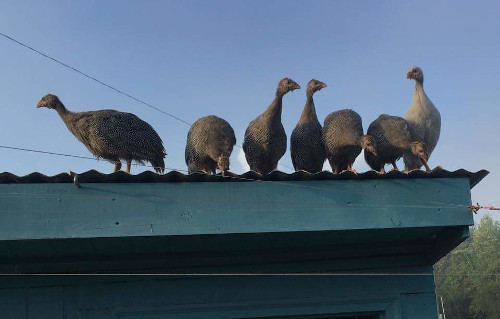Do Guinea fowl need a coop?

Guinea fowl do need shelter but it does not necessarily have to be a coop.
Being from the same family as pheasants and turkeys they prefer to roost in the trees but in order to keep them around and find the eggs easily you really need to provide them with housing and train them in it's use.
Below: Guineas prefer the natural feel to the coop.

It is useful to be able to catch them occasionally and penning them up for part of the time, especially the mornings will help prevent them from becoming totally wild.
What kind of coop do Guineas need?
Guinea fowl need a bigger and taller coop than chickens do. They prefer to roost higher and need more space to prevent aggression.
I keep an egg flock of 27 guineas in a 10 foot by 8 foot shed with the roosts 8 foot off the floor. It does not need to be elaborate in any way, just a shed with sand on the floor will be fine.
Guinea fowl housing requirements are:
- Height - Guineas like to be up high so you need to provide high spots.
- Nests - Secluded area with shallow dips filled with sand and dry grass.
- A secure coop, and a fenced and covered run. To keep them in and predators out.
- Two pop holes. Guinea can squabble like politicians over nothing for hours.
- Round wooden perches. Guinea love to perch up high.
Below: Guineas high up on natural perches.

Guinea fowl houses really need to have an attached run, the birds will need to be kept in for their training which will take at least 4 weeks.
Can you keep Guinea fowl in a chicken coop?
You can keep Guineas in a chicken coop but it need to be a bigger one than you would normally get as Guinea fowl need more space, both inside the coop and in the run.
The Plastic and smaller chicken coops are not suitable for keeping Guinea fowl.
How much coop space does a Guinea fowl need?
Guineas need at least 2 square foot in the coop and 10 square foot of floor space in the run, which is around twice as much space as chickens do in the coop. Guinea fowl also require more perch space and height, both in the coop and in the run.
Below: Guineas don't snuggle up close like chickens do.

Where should I put the Guinea fowl coop?
At least 100 yards from human houses if you do not want yourselves and your neighbours being disturbed.
In some parts of the world there are minimums set in law for distances poultry must be away from habitation. Guinea fowl are noisy and really make a surprisingly large amount of noise over the greater part of the day.
An enclosed run should be sheltered but have sunshine and fresh air. Cover it if you live in a very wet or snowy part of the country.
Guineas can be trained to use an out building. It is much better than letting them sleep outdoors in a tree. Out buildings are clean, dry, provides protection from the weather elements, and most of all, offers overnight protection from predators.
Getting Guinea fowl back to the coop at night:
It is important to train them from young to think of the coop as home. This ensures that they will return when they do go wandering. This is most easily accomplished by raising them with a hen, she will teach them some chicken ways and make the easier to keep.
Below: I get an email a week asking me what to do about Guineas that roost on the coop rather than in it.

Clip one wing of it's primary flight feathers a few days before the planned first free ranging, this will unbalance them in flight.
By keeping them in their intended home for at least a month it is possible to persuade them to return to a shed each evening in order to roost.
The Guinea fowl owner who is lucky enough to have an out-building attached to their property will find that birds will prefer to roost on any exposed rafters or beams. You can help this by putting a few branches in the beams.
Food helps here and by feeding them in the coop or run in the morning before release and in the evening before roosting it will help bring them back.
When releasing young Guinea fowl from the coop for the first time, just let half of them out. Their strong flock mentality will ensure that the ones on the outside will stay close to the coop.
Eventually they will all learn that the coop is home. They are flocking birds and tend to follow what the bulk of them do, if most roost in the coop, the rest will tend to, but not always, follow.
Do Guinea fowl need a nest box?
Left to her own devices, the Guinea hen would, like most birds, lay a clutch of eggs and then go broody. By collecting the eggs it isn't unreasonable to expect a hen to carry on laying until she has produced as many as 160 eggs.
Chicken style nest boxes are totally unnecessary and will be ignored in favour of a stubbornly self-chosen, well-hidden nest. Or a shallow basin like depression in the ground or coop floor bedding.
The best thing you can do is create artificial nesting spots that are easy for you to get to and hope the Guinea hens choose them as their preferred spot to lay. Some logs or branches carefully constructed to enclose a dry sheltered spot where you can make a shallow dip and put a few pottery eggs in as a decoy.
Unlike with all other poultry take care not be seen when removing the eggs from the nest. Always do it when you know that the bird is not around to see you and never remove them all otherwise the hen will find somewhere else to lay. then you have to go through the bother of finding the new location. Pottery eggs or golf balls work just fine as nest egg substitutes.
For the complete guide to a Guinea fowl nesting behaviour.
Do Guinea fowl need perches in the coop?
Guinea fowl need perches and their preference is for round wood. This mimics what they would perch on in the wild.
Below: Guinea fowl spend a lot of time perching, both inside the coop and outside.
Mine seem to prefer natural wood perches so go for branches in the coop.
